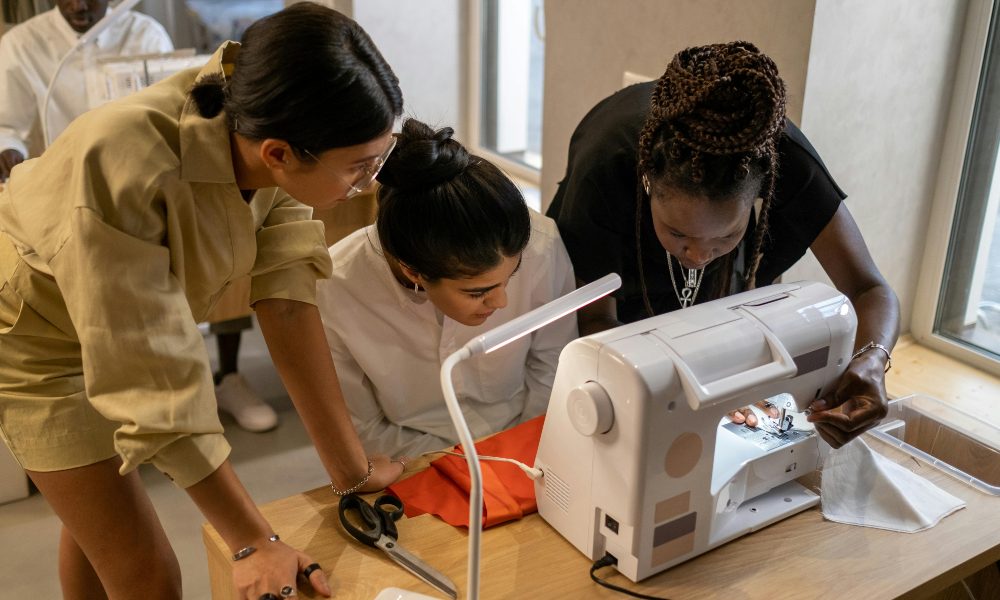Have you ever wondered what’s happening inside your sewing machine that allows it to stitch fabric together quickly? Sewing machines may seem complicated, but learning about their inner workings helps you use them more effectively.
Read on to learn about the history of sewing machines, their main components, and how they create stitches. Knowing the basics of how a sewing machine works gives you a better mastery of your craft.
A Brief History of the Sewing Machine
Before home sewing machines became common in the 1850s, all sewing was done by hand. Skilled seamstresses worked long hours stitching clothing, quilts, upholstery, and other household items. Sewing was necessary but incredibly laborious and time-consuming.
The first sewing machine was invented by Walter Hunt in 1834. His primitive machine used an eye-pointed needle, and a later version incorporated a shuttle to form a basic chain stitch. However, Hunt never successfully marketed his invention.
It was Barthélemy Thimonnier who patented the first practical sewing machine in 1830 in France. His machine used a hook rather than a shuttle, and soon, he was mass-producing uniforms for the French army. But workers, fearing loss of hand-sewing jobs, destroyed his factory!
Industrial sewing machines started transforming garment factories in the late 1800s. Elias Howe’s lockstitch machine of 1846, plus the invention of the foot-powered treadle machine, enabled mass production of clothing. Home sewing machines grew in popularity and availability as inventors like Isaac Singer improved designs and aggressively marketed the new tools.
Main Components of a Sewing Machine
While early sewing machines could only manage a straight stitch, most modern home sewing machines contain the following parts that allow them to make various stitches:
The Needle
The hardened steel needle has a sharp point to pierce the fabric and an eye near the bottom to carry the top thread down through the fabric – the needle size and type impact performance.
Presser Foot
The presser foot applies pressure, holding the fabric against the feed dogs and needle plate as stitches form. Many styles include zipper, buttonhole, zigzag, and embroidery feet.
Feed Dogs
Located under the presser foot, the feed dogs have serrated teeth that grab the fabric and advance it through the machine for consistent stitch length. They control the movement of the fabric.
Bobbin and Bobbin Case
The bobbin is a spool that holds the lower thread. It sits in a case under the needle plate. As the needle thread passes through the fabric, a hook catches the bobbin thread to form the interlocking stitch.
Needle Plate
This is the metal piece the fabric passes over, usually with markings to guide seam allowances. It supports the fabric and has an opening for the needle.
Stitch Length Regulator
This mechanism controls the length of each stitch made. It determines how far the feed dogs advance the fabric with each needle puncture.
How a Basic Sewing Machine Works

Now that we know the key components, let’s look at how they work together:
Threading the Top Thread and Bobbin
The top thread unwinds from a spool and passes through thread guides leading to the take-up lever. This lever pulls up any slack. It then goes through the tension assembly, which maintains proper tension on the thread. Finally, it passes through the needle eye.
The bobbin spool goes into its case underneath the needle plate. Thread feeds through a tension spring and hole in the case.
Starting to Sew
Balancing the bobbin and upper thread tension is vital for quality sewing. The user also selects the desired stitch type and length.
As the needle pierces fabric, a hook behind the needle area catches the bobbin thread, forming a lockstitch. Feed dogs advance the fabric and the preset stitch length, and the cycle repeats.
Types of Stitches
In addition to the basic straight stitch, most machines can make others:
- Zigzag – goes side to side in a zigzag pattern, allowing stretch in seams.
- Decorative – various patterns like scallops and swirls for embellishing.
- Stretch – tiny zigzags let seams stretch without breaking the thread.
- Multi-step – combination stitches like buttonholes.
Sewing Machine Applications
Sewing machines are utilized in homes and industry:
- Clothing, fashion, and craft design.
- Quilting, embroidery, and sewing craft projects.
- Upholstery work on furniture, automobile interiors, etc.
- Industrial machines mass-produce all varieties of sewn goods.
Frequently Asked Questions
What are the essential parts of a sewing machine?
The main parts are the needle, presser foot, feed dogs, bobbin and case, needle plate, and stitch length regulator.
How does the needlework?
The sharp steel needle pierces the fabric, carrying the top thread down through the material to form a stitch with the bobbin thread.
What do the feed dogs do?
The feed dogs are the rough teeth under the presser foot that advance the fabric through the machine for consistent stitch length.
How does the bobbin thread work?
The bobbin sits in a case under the needle plate, holding the bottom thread. As the needle thread passes through the fabric, a hook catches the bobbin thread to create a locked stitch.
What controls the stitch length?
The stitch length regulator determines how far the feed dogs advance the fabric with each needle puncture, controlling the stitch size.
How are different types of stitches made?
By changing the movement of the feed dogs and needle, the machine can make zigzag, decorative, stretch, and multi-step stitches.
Conclusion
I hope this overview helped explain what’s happening inside your sewing machine! Understanding the basic mechanics allows you to use your machine more efficiently and fix minor issues. Knowledge of how sewing machines work gives you the confidence to complete any project.
It’s incredible how 18th-century inventions like those of Hunt and Thimonnier evolved into the versatile sewing machines we use today. What other tools do we now take for granted have such untold developmental histories? Let me know your thoughts!
***
Main image: pexels




